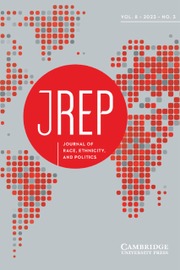No CrossRef data available.
Article contents
Demographic Shifts and Public Attitudes Toward the January 6th Attack
Published online by Cambridge University Press: 26 March 2025
Abstract
This paper examines the impact of demographic change on political perceptions, specifically attitudes toward the January 6th attack on the U.S. Capitol. Utilizing data from the 2020 Collaborative Multiracial Post-Election Survey, we explore how changes in county-level nonwhite populations influence whether individuals label the event as a protest or an insurrection. Our findings reveal a curvilinear relationship: respondents in counties with moderate increases in nonwhite populations are more likely to view the event as an insurrection, while those in counties with substantial increases tend to see it as a protest. This pattern holds across racial groups but is primarily driven by respondents who did not vote for President Trump. The study shows the broader implications of demographic shifts on political stability and social cohesion, highlighting how changes in racial and ethnic composition shape interpretations of major political events. These insights are crucial for understanding voter behavior and political messaging in the 2024 presidential election.
- Type
- Research Article
- Information
- Copyright
- © The Author(s), 2025. Published by Cambridge University Press on behalf of The Race, Ethnicity, and Politics Section of the American Political Science Association


